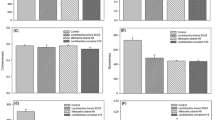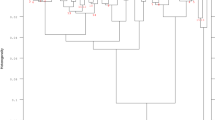Abstract
The selection of lactic acid bacteria strains is interesting for the development of sourdough to obtain wheat bread with improved technological and nutritional properties. In this work, the performance of ten different LAB strains isolated from diverse cereals in wheat sourdough was evaluated. Five facultative heterofermentative (Lactobacillus pentosus ES124, Lactobacillus paralimentarius ES259, Lactobacillus plantarum ES137, Lactobacillus plantarum ATCC8014 and Lactobacillus plantarum ES147), three obligately heterofermentative (Lactobacillus brevis ES253, Lactobacillus fermentum ES142 and Lactobacillus fermentum ES148) and two homofermentative (Pediococcus acidilactici ES22 and Enterococcus faecium ES74) lactic acid bacteria strains were evaluated in ten single strain fermentations. Sugar profile, volatile compounds and proteolytic ability of sourdoughs were analyzed. The microbiological counts showed that facultative heterofermentative strains presented higher counts than homofermentative sourdoughs. Monosaccharides (glucose and fructose), maltose and sucrose, isomaltose and dextrin were detected in fermentations with homofermentative strains whilst in those with heterofermentative strains maltose/sucrose, isomaltose and dextrin were found. L. paralimentarius ES259 and L. pentosus ES124 showed the highest diversity of volatile compounds. L. plantarum ES137 and P. acidilactici ES22 were the strains with the highest proteolytic activity. The technological performance allowed us to select LAB as starters to develop breads with specific rheological properties and final quality.



Similar content being viewed by others
References
De Vuyst L, Vrancken G, Ravyts F et al (2009) Biodiversity, ecological determinants, and metabolic exploitation of sourdough microbiota. Food Microbiol 26:666–675. https://doi.org/10.1016/j.fm.2009.07.012
Gobbetti M, De Angelis M, Di Cagno R et al (2019) Novel insights on the functional/nutritional features of the sourdough fermentation. Int J Food Microbiol 302:103–113. https://doi.org/10.1016/j.ijfoodmicro.2018.05.018
Hammes WP, Gänzle MG (1998) Sourdough breads and related products. In: Wood BJB (ed) Microbiology of Fermented Foods. Springer, US, Boston, MA, pp 199–216
Corsetti A, Settanni L (2007) Lactobacilli in sourdough fermentation. Food Res Int 40:539–558. https://doi.org/10.1016/j.foodres.2006.11.001
Gobbetti M, Rizzello CG, Di Cagno R, De Angelis M (2014) How the sourdough may affect the functional features of leavened baked goods. Food Microbiol 37:30–40. https://doi.org/10.1016/j.fm.2013.04.012
Gänzle MG (2014) Enzymatic and bacterial conversions during sourdough fermentation. Food Microbiol 37:2–10. https://doi.org/10.1016/j.fm.2013.04.007
Casado A, Álvarez A, González L, et al (2017) Effect of fermentation on microbiological, physicochemical and physical characteristics of sourdough and impact of its use on bread quality. Czech J Food Sci 35(2017):496–506. https://doi.org/https://doi.org/10.17221/68/2017-CJFS
Minervini F, De Angelis M, Di Cagno R, Gobbetti M (2014) Ecological parameters influencing microbial diversity and stability of traditional sourdough. Int J Food Microbiol 171:136–146. https://doi.org/10.1016/j.ijfoodmicro.2013.11.021
Zhao CJ, Schieber A, Gänzle MG (2016) Formation of taste-active amino acids, amino acid derivatives and peptides in food fermentations – A review. Food Res Int 89:39–47. https://doi.org/10.1016/j.foodres.2016.08.042
Di Cagno R, De Angelis M, Lavermicocca P et al (2002a) Proteolysis by sourdough lactic acid bacteria: effects on wheat flour protein fractions and gliadin peptides involved in human cereal intolerance. Appl Environ Microbiol 68:623–633. https://doi.org/10.1128/AEM.68.2.623-633.2002
Aponte M, Boscaino F, Sorrentino A et al (2013) Volatile compounds and bacterial community dynamics of chestnut-flour-based sourdoughs. Food Chem 141:2394–2404. https://doi.org/10.1016/j.foodchem.2013.05.052
Pontonio E, Nionelli L, Curiel JA et al (2015) Iranian wheat flours from rural and industrial mills: exploitation of the chemical and technology features, and selection of autochthonous sourdough starters for making breads. Food Microbiol 47:99–110. https://doi.org/10.1016/j.fm.2014.10.011
Nionelli L, Curri N, Curiel JA et al (2014) Exploitation of Albanian wheat cultivars: characterization of the flours and lactic acid bacteria microbiota, and selection of starters for sourdough fermentation. Food Microbiol 44:96–107. https://doi.org/10.1016/j.fm.2014.05.011
Corona O, Alfonzo A, Ventimiglia G et al (2016) Industrial application of selected lactic acid bacteria isolated from local semolinas for typical sourdough bread production. Food Microbiol 59:43–56. https://doi.org/10.1016/j.fm.2016.05.006
Rizzello CG, Lorusso A, Montemurro M, Gobbetti M (2016) Use of sourdough made with quinoa (Chenopodium quinoa) flour and autochthonous selected lactic acid bacteria for enhancing the nutritional, textural and sensory features of white bread. Food Microbiol 56:1–13. https://doi.org/10.1016/j.fm.2015.11.018
Ogunsakin AO, Vanajakshi V, Anu-Appaiah KA et al (2017) Evaluation of functionally important lactic acid bacteria and yeasts from Nigerian sorghum as starter cultures for gluten-free sourdough preparation. LWT - Food Sci Technol 82:326–334. https://doi.org/10.1016/j.lwt.2017.04.048
Olojede AO, Sanni AI, Banwo K (2020) Rheological, textural and nutritional properties of gluten-free sourdough made with functionally important lactic acid bacteria and yeast from Nigerian sorghum. LWT 120:108875. https://doi.org/10.1016/j.lwt.2019.108875
Dertli E, Mercan E, Arıcı M et al (2016) Characterisation of lactic acid bacteria from Turkish sourdough and determination of their exopolysaccharide (EPS) production characteristics. LWT - Food Sci Technol 71:116–124. https://doi.org/10.1016/j.lwt.2016.03.030
Siepmann FB, de Almeida BS, Ripari V et al (2019) Brazilian sourdough: microbiological, structural, and technological evolution. Eur Food Res Technol 245:1583–1594. https://doi.org/10.1007/s00217-019-03254-8
Pétel C, Onno B, Prost C (2017) Sourdough volatile compounds and their contribution to bread: a review. Trends Food Sci Technol. https://doi.org/10.1016/j.tifs.2016.10.015
Salvucci E, LeBlanc JG, Pérez G (2016) Technological properties of Lactic acid bacteria isolated from raw cereal material. LWT 70:185–191. https://doi.org/10.1016/j.lwt.2016.02.043
Man JCD, Rogosa M, Sharpe ME (1960) A medium for the cultivation of lactobacilli. J Appl Bacteriol 23:130–135. https://doi.org/10.1111/j.1365-2672.1960.tb00188.x
Raibaud P, Caulet M, Galpin JV, Mocquot G (1961) Studies on the bacterial flora of the alimentary tract of pigs. ii. streptococci: selective enumeration and differentiation of the dominant group. J Appl Bacteriol 24:285–306. https://doi.org/10.1111/j.1365-2672.1961.tb00262.x
Lefebvre D, Gabriel V, Vayssier Y, Fontagné-Faucher C (2002) Simultaneous HPLC determination of sugars, organic acids and ethanol in sourdough process. LWT - Food Sci Technol 35:407–414. https://doi.org/10.1006/fstl.2001.0859
Rangaswamy S, Agblevor F (2002) Screening of facultative anaerobic bacteria utilizing D -xylose for xylitol production. Applied Microbiology and Biotechnology 60:88–93. https://doi.org/10.1007/s00253-002-1067-8
Kaseleht K, Paalme T, Mihhalevski A, Sarand I (2011) Analysis of volatile compounds produced by different species of lactobacilli in rye sourdough using multiple headspace extraction: volatiles produced by LAB in sourdough. Int J Food Sci Technol 46:1940–1946. https://doi.org/10.1111/j.1365-2621.2011.02705.x
Laemmli UK (1970) Cleavage of structural proteins during the assembly of the head of bacteriophage T4. Nature 227:680–685. https://doi.org/10.1038/227680a0
Fazeli MR, Shahverdi AR, Sedaghat B et al (2004) Sourdough-isolated Lactobacillus fermentum as a potent anti-mould preservative of a traditional Iranian bread. Eur Food Res Technol 218:554–556. https://doi.org/10.1007/s00217-004-0898-1
Yin Y, Wang J, Yang S et al (2015) Protein degradation in wheat sourdough fermentation with lactobacillus plantarum M616. Interdiscip Sci Comput Life Sci 7:205–210. https://doi.org/10.1007/s12539-015-0262-0
Stanzer D, Ivanuša I, Kazazić S et al (2017) Diversity of lactic acid bacteria on organic flours and application of isolates in sourdough fermentation. Croat J Food Techno Biotechnol Nutr 12:44–51
De Vuyst L, Van Kerrebroeck S, Harth H et al (2014) Microbial ecology of sourdough fermentations: diverse or uniform? Food Microbiol 37:11–29. https://doi.org/10.1016/j.fm.2013.06.002
Paramithiotis S, Chouliaras Y, Tsakalidou E, Kalantzopoulos G (2005) Application of selected starter cultures for the production of wheat sourdough bread using a traditional three-stage procedure. Process Biochem 40:2813–2819. https://doi.org/10.1016/j.procbio.2004.12.021
Chavan RS, Chavan SR (2011) Sourdough technology—a traditional way for wholesome foods: a review. Compr Rev Food Sci Food Saf 10:169–182. https://doi.org/10.1111/j.1541-4337.2011.00148.x
Vrancken G, Vuyst LD, Rimaux T et al (2011) Adaptation of Lactobacillus plantarum IMDO 130201, a wheat sourdough isolate, to growth in wheat sourdough simulation medium at different pH values through differential gene expression. Appl Environ Microbiol 77:3406–3412. https://doi.org/10.1128/AEM.02668-10
Van der Meulen R, Scheirlinck I, Van Schoor A et al (2007) Population dynamics and metabolite target analysis of lactic acid bacteria during laboratory fermentations of wheat and spelt sourdoughs. Appl Environ Microbiol 73:4741–4750. https://doi.org/10.1128/AEM.00315-07
Ravyts F, De Vuyst L (2011) Prevalence and impact of single-strain starter cultures of lactic acid bacteria on metabolite formation in sourdough. Food Microbiol 28:1129–1139. https://doi.org/10.1016/j.fm.2011.03.004
Robert H, Gabriel V, Lefebvre D et al (2006) Study of the behaviour of Lactobacillus plantarum and Leuconostoc starters during a complete wheat sourdough breadmaking process. LWT—Food Sci Technol 3:256–265. https://doi.org/10.1016/j.lwt.2005.01.013
Birch AN, Petersen MA, Hansen ÅS (2013) The aroma profile of wheat bread crumb influenced by yeast concentration and fermentation temperature. LWT—Food Sci Technol 50:480–488. https://doi.org/10.1016/j.lwt.2012.08.019
Damiani P, Gobbetti M, Cossignani L et al (1996) The Sourdough microflora. characterization of hetero- and homofermentative lactic acid bacteria, yeasts and their interactions on the basis of the volatile compounds produced. LWT—Food Sci Technol 29:63–70. https://doi.org/10.1006/fstl.1996.0009
Czerny M, Schieberle P (2002) Important aroma compounds in freshly ground wholemeal and white wheat flour-identification and quantitative changes during sourdough fermentation. J Agric Food Chem 50:6835–6840
Vermeulen N, Czerny M, Gänzle MG et al (2007) Reduction of (E)-2-nonenal and (E, E)-2,4-decadienal during sourdough fermentation. J Cereal Sci 45:78–87. https://doi.org/10.1016/j.jcs.2006.07.002
Lorenz, K (1983) Sourdough processes: methodology and biochemistry. Bakers Digest
Gobbetti M, Lavermicocca P, Minervini F et al (2000) Arabinose fermentation by Lactobacillus plantarum in sourdough with added pentosans and αα-L-arabinofuranosidase: a tool to increase the production of acetic acid. J Appl Microbiol 88:317–324. https://doi.org/10.1046/j.1365-2672.2000.00962.x
Thiele C, Grassl S, Gänzle M (2004) Gluten hydrolysis and depolymerization during sourdough fermentation. J Agric Food Chem 52:1307–1314. https://doi.org/10.1021/jf034470z
Di Cagno R, De Angelis M, Lavermicocca P et al (2002b) Proteolysis by sourdough lactic acid bacteria: effects on wheat flour protein fractions and gliadin peptides involved in human cereal intolerance. Appl Environ Microbiol 68:623–633. https://doi.org/10.1128/AEM.68.2.623-633.2002
Gerez CL, Rollán GC, de Valdez GF (2006) Gluten breakdown by lactobacilli and pediococci strains isolated from sourdough. Lett Appl Microbiol 42:459–464. https://doi.org/10.1111/j.1472-765X.2006.01889.x
Llorente-Bousquets A, Pérez-Munguía S, Farrés A (2008) Novel extracellular proteolytic activity in Pediococcus acidilactici ATCC 8042. Can J Microbiol 54:694–699. https://doi.org/10.1139/W08-055
Gandhi D, Chanalia P, Attri P, Dhanda S (2016) Dipeptidyl peptidase-II from probiotic pediococcus acidilactici: purification and functional characterization. Int J Biol Macromol 93:919–932. https://doi.org/10.1016/j.ijbiomac.2016.09.023
Spicher G, Nierle W (1988) Proteolytic activity of sourdough bacteria. Appl Microbiol Biotechnol 28:487–492. https://doi.org/10.1007/BF00268220
Acknowledgements
The authors acknowledge Dr. Pablo Yunes for the technical assistance and Prof. Brenda Burgos for providing useful suggestions to improve the English in this manuscript. Authors would like to thanks CONICET and the Agencia Nacional de Promoción Científica y Tecnológica (Grant PICT 2015-3803) for their financial support.
Funding
Funding was provided by Fondo para la Investigación Científica y Tecnológica (Grant No. 2015-3803).
Author information
Authors and Affiliations
Corresponding author
Additional information
Publisher's Note
Springer Nature remains neutral with regard to jurisdictional claims in published maps and institutional affiliations.
Rights and permissions
About this article
Cite this article
Lancetti, R., Sciarini, L., Pérez, G.T. et al. Technological Performance and Selection of Lactic Acid Bacteria Isolated from Argentinian Grains as Starters for Wheat Sourdough. Curr Microbiol 78, 255–264 (2021). https://doi.org/10.1007/s00284-020-02250-6
Received:
Accepted:
Published:
Issue Date:
DOI: https://doi.org/10.1007/s00284-020-02250-6




